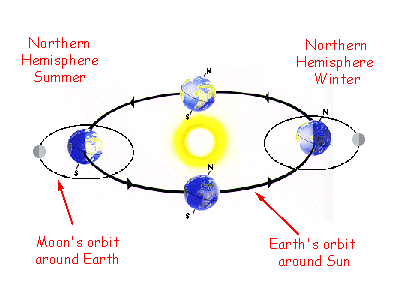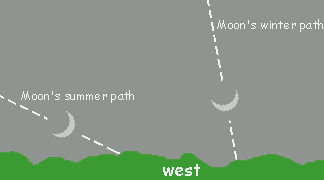Why is the crescent Moon sometimes lit on the bottom?
![]()
A careful observer will certainly notice that over the period of months, the crescent of the Moon does indeed seem to go from being lit on the "bottom" of the Moon to being lit on the side of the Moon. So what is happening to make the Moon look different? It is all a result of the Moon's orbit around the Earth, and the Earth's orbit around the Sun. And exactly when you see the Moon in the shape of a 'U' (lit on the bottom) rather than a backward 'C' (lit on the side) depends on what latitude you are at. But the explanation is the same regardless of when you see it from your location.
|
We see the Moon in the night sky because it is reflecting light from the Sun. The Moon does not generate any light of its own. So the lit part of the Moon always points toward the Sun. Now as you can see in the diagram, as the Earth travels aroound the Sun, the tilt of the Earth on its axis sometimes points the northern hemisphere toward the Sun and sometimes points the southern hemisphere toward the Sun. This is why we have seasons here on Earth. But this also changes the apparent path of the Moon across the night sky when you are on the Earth looking out at it. Sometimes it travels at an angle toward the horizon and sometimes it travels straight down toward the horizon. When the crescent Moon travels straight down toward the horizon, you will get the 'U' shaped Moon. Many describe this as when the 'horns' of the Moon point upward. This can happen once or twice a year, again depending on the latitude of your location. |  |
 |
|
This diagram shows typical paths for the Moon during the year (and the
resulting look of the waxing crescent Moon) for a specific latutude in the northern hemisphere. Notice that during winter, the
Moon sets north of west and follows a path almost straight down to the horizon. During the summer, the Moon sets south of
west and follows a slanted path down to the horizon. |
This change in the appearance of the Moon has been observed for a very long time. And many conflicting definitions have been given to these lunar appearances.
Some ancient skywatchers spoke of the crescent Moon when the bottom seems to be lit as the "wet moon". They thought it looked like a bowl which could fill up with the rain and snow of the winter season. In Hawaiian astrology, Kaelo the Water Bearer rules from January 20 - February 18. According to the Hawaiian Calendar, Kaelo is the "Dripping Wet Moon" month. However, many other cultures have defined the Moon when lit on the bottom as the "dry moon" since in that configuration, the Moon is "holding in the water".
As winter passes into spring and summer, the crescent shape slowly shifts toward the south and begins to "stand on its end". To some ancients, this represented the Moon assuming a pouring position in which it will lose its water and result in the great summer rains. The result was the creation of a "dry moon", one which held no water because it all poured out. On the other hand, other cultures said that such a moon is a wet moon because it allowed the water to pour out!
![]()
The StarChild site is a service of the High Energy Astrophysics Science Archive Research Center (HEASARC), within the Astrophysics Science Division (ASD) at NASA/ GSFC.
StarChild Authors: The StarChild Team
StarChild Graphics & Music: Acknowledgments
StarChild Project Leader: Dr. Laura A.
Whitlock
Curator:
Responsible NASA Official: